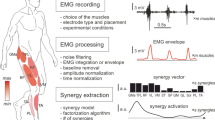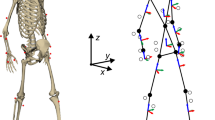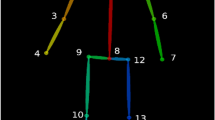Abstract
In the field of 3D reconstruction of human motion from video, model-based techniques have been proposed to increase the estimation accuracy and the degree of automation. The feasibility of this approach is strictly connected with the adopted biomechanical model. Particularly, the representation of the kinematic chain and the assessment of the corresponding parameters play a relevant role for the success of the motion assessment. In this paper, the focus is on the determination of the kinematic parameters of a general hand skeleton model using surface measurements. A novel method that integrates nonrigid sphere fitting and evolutionary optimization is proposed to estimate the centers and the functional axes of rotation of the skeletal joints. The reliability of the technique is tested using real movement data and simulated motions with known ground truth 3D measurement noise and different ranges of motion (RoM). With respect to standard nonrigid sphere fitting techniques, the proposed method performs 10–50% better in the best condition (very low noise and wide RoM) and over 100% better with physiological artifacts and RoM. Repeatability in the range of a couple of millimeters, on the localization of the centers of rotation, and in the range of one degree, on the axis directions is obtained from real data experiments.
Similar content being viewed by others
References
Alexander, E. J., and T. P. Andriacchi. Correcting for deformation in skin-based marker systems. J. Biomech. 34:355–361, 2001.
Bäck, T., G. Rudolph, and H. P. Schwefel. Evolutionary programming and evolution strategies: Similarities and differences. In: Proceedings of the Second Annual Conference on Evolutionary Programming, edited by D. B. Fogel and W. Atmar. La Jolla, CA: Evolutionary Programming Society, 1993, pp. 11–22.
Biggs, J., and K. Horch. A three-dimensional kinematic model of the human long finger and the muscles that actuate it. Med. Eng. Phis. 21:625–639, 1999.
Brand, P. W., and A. M. Hollister. Clinical Biomechanics of the Hand, 3rd ed. St. Louis, MO: Mosby, 1999.
Buchholz, B., and T. J. Armstrong. A kinematic model of the human hand to evaluate its prehensile capabilities. J. Biomech. 25:149–162, 1992.
Cappozzo, A., F. Catani, A. Leardini, M. G. Benedetti, and U. Della Croce. Position and orientation in space of bones during movement: experimental artifacts. Clin. Biomech. 11:90–10, 1996.
Cerveri, P., A. Pedotti, and N. A. Borghese. Combined evolution strategies for dynamic calibration of video-based movements measurement systems. IEEE Trans. Evol. Comput. 5:271–282, 2001.
Cerveri, P., A. Pedotti, and G. Ferrigno. Model-based approach and extended Kalman filters for accurate human motion estimation. Hum. Move. Sci. 22:377–404, 2003.
Coert, J. H., H. G. van Dijke, S. E. Hovius, C. J. Snijders, and M. F. Meek. Quantifying thumb rotation during circumduction utilizing a video technique. J. Orthoped. Res. 21:1151–1155, 2003.
Chiu, H. Y., F. C. Su, S. T. Wang, and H. Y. Hsu. The motion analysis system and goniometry of the finger joints. J. Hand Surg. B 23:788–791, 1998
Flanagan, J. R., and R. S. Johansson. Hand movements. Encycloped. Hum. Brain 2:399–414, 2002.
Gamage, S. S. H. U., and J. Lasenby. New least square solutions for estimating the average center of rotation and axis of rotation. J. Biomech. 35:87–93, 2002.
Halvorsen, K., M. Lesser, and A. Lundberg. A new method for estimating the axis of rotation and the center of rotation. J. Biomech. 32:1221–1227, 1999.
Hansen, N., and A. Ostermeier. Completely derandomized self-adaptation in evolution strategies. Evol. Comput. 9:159–195, 2001.
Kaelbing, L. P., M. L. Littman, and A. W. Moore. Reinforcement learning: A survey. J. Artific. Intell. Res. 4:237–285, 1996.
Leijnse, J. N., C. J. Snijders, J. E. Bonte, J. M. Landsmeer, J. J. Kalker, J. C. Van der Meulen, G. J. Sonneveld, and S. E. Hovius. The hand of the musician: The kinematics of the bidigital finger system with anatomical restrictions. J. Biomech. 26:1169–1179, 1993.
Leijnse, J. N. and J. J. Kalkar. A two-dimensional kinematics modal of the lumbrical in the human finger. J. Biomech. 28:237–249, 1995.
Lundberg, A. On the use of bone and skin markers in kinematics research. Hum. Move. Sci. 15:411–422, 1996.
Marin, F., H. Mannel, L. Claes, and L. Dürselen. Accurate determination of a joint rotation center based on the minimal amplitude point method. Comp. Aided Surg. 8:30–42, 2003.
Novak, K. E., L. E. Miller, and J. C. Houk Kinematic properties of rapid hand movements in a knob turning task. Exp. Brain Res. 132:419–433, 2000.
Rash, G. S., P. P. Belliappa, M. P. Wachowiak, N. N. Somia, and A. Gupta. A demonstration of validity of 3-D video motion analysis method for measuring finger flexion and extension. J. Biomech. 32:1337–1341, 1999.
Reinschmidt, C., A. J. van den Bogert, B. M. Nigg, A. Lundberg, and N. Murphy. Effect of skin movement on the analysis of skeletal knee joint motion during running. J. Biomech. 30:729–732, 1997.
Pavlovic, V., R. Sharma, and T. S. Huang. Visual interpretation of hand gestures for human–computer interaction: A review. IEEE Patt. Anal. Mach. Intell. 19(7):677–695, 1997.
Press, W. H., B. P. Flannery, S. A. Teukolsky, and W. T. Vetterling. Numerical Recipes in C. Cambridge, UK:Cambridge University Press, 1992.
Santello, M., M. Flanders, and J. F. Soechting. Patterns of hand motion during grasping and the influence of sensory guidance. J. Neurosci. 22:1426–1435, 2002.
Silaghi, M., R. Plaenkers, R. Boulic, P. Fua, and D. Thalmann. Local and global skeleton fitting techniques for optical motion capture. In: Modelling and Motion Capture Techniques for Virtual Environments, Lecture Notes in Artifcial Intelligence, No. 1537, edited by N. Magnenat-Thalmann and D. Thalmann. Berlin: Springer, 1998, pp. 26–40.
Söderkvist, T., and P.-A. Wedin. Determining the movements of the skeleton using well-configured markers. J. Biomech. 12:1473–1477, 1993.
Wu, W., M. J. Black, D. Mumford, Y. Gao, E. Bienenstock, and J. P. Pavlovic. Modeling and decoding motor cortical activity using a switching Kalman filter. IEEE Trans. Biomed. Eng. 51(6):933–942, 2004.
Wu, Y., and T. S. Huang. Hand modeling, analysis and recognition, for vision-based human computer interaction. IEEE Sign. Process. Mag. 1053-5888/01/s10.00, 2001.
Zhang, X., S. W. Lee, and P. Braido. Determining finger segmental centers of rotation in flexion-extension based on surface marker measurement. J. Biomech. 36:1097–1102, 2003.
Author information
Authors and Affiliations
Corresponding author
Rights and permissions
About this article
Cite this article
Cerveri, P., Lopomo, N., Pedotti, A. et al. Derivation of Centers and Axes of Rotation for Wrist and Fingers in a Hand Kinematic Model: Methods and Reliability Results. Ann Biomed Eng 33, 402–412 (2005). https://doi.org/10.1007/s10439-005-1743-9
Received:
Accepted:
Issue Date:
DOI: https://doi.org/10.1007/s10439-005-1743-9




